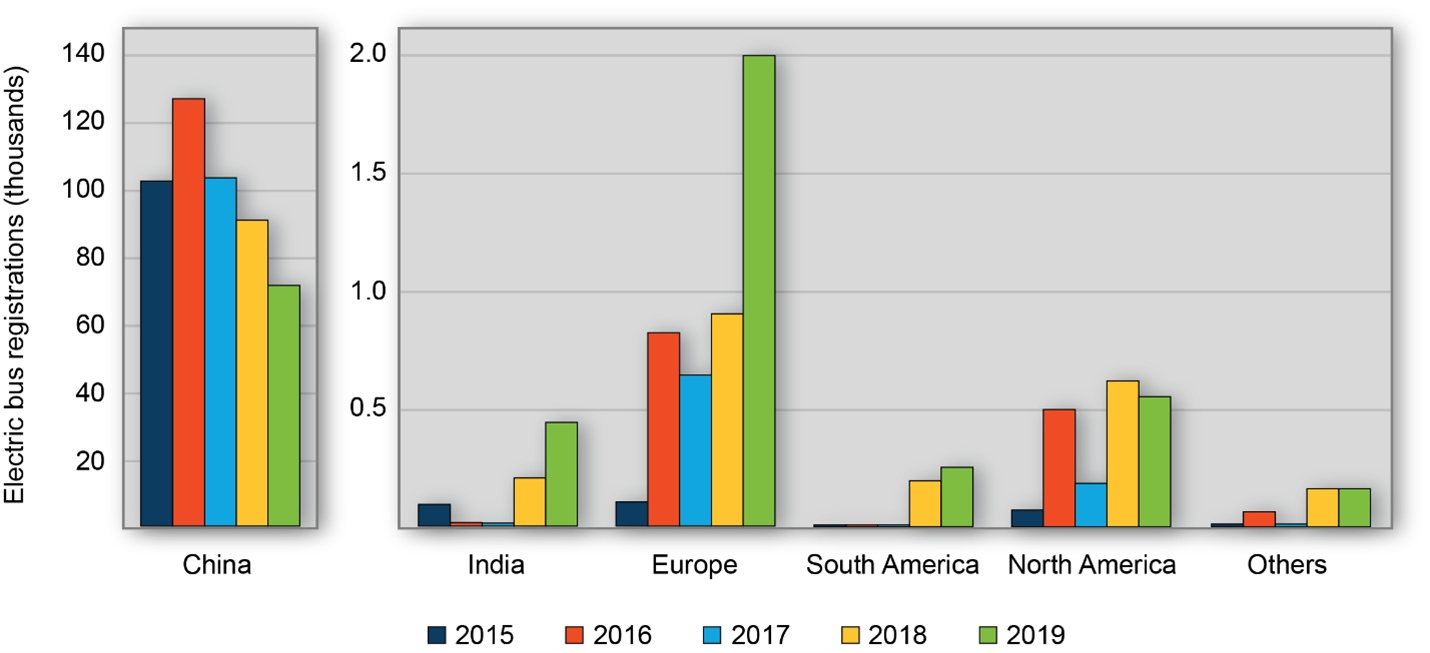The Future of Heavy-Duty Electric Vehicles: Closer Than You Think
January 19, 2021 | Jack Acomb | Education

While the recent rapid growth of the electric vehicle (EV) market makes EVs increasingly accessible, the availability of EV models is uneven across vehicle types. While electric passenger vehicle models like sedans are increasingly available to consumers, medium- and heavy-duty EVs are largely in their infancy. However, progress is underway on heavier-duty EVs—the technology is much closer than you might think.
Electrifying Bus Fleets
Municipalities around the US and globally have already spearheaded the transition to heavy-duty EVs through their adoption of electric transit buses. BloombergNEF’s Electric Vehicle Outlook 2020 report provides data and projections on the EV market that quantifies many of these trends. According to their data from 2019, there were roughly 650 electric buses already deployed in American cities ranging from Los Angeles, California, to Lexington, Kentucky. In Minnesota, Metro Transit deployed its first eight fully electric transit buses on its C Line in 2019.
Looking abroad, BloombergNEF data show that cities like Beijing or Shanghai have already amassed sizeable electric bus fleets, with an estimated 421,000 electric buses in use in China nationwide. This total represents approximately 17 percent of the country’s overall transit bus fleet. Figure 1 below shows that China accounts for an overwhelming majority of the newly registered electric buses globally (note the difference in scales between China and the rest of the world).
Figure 1. Electric bus registrations by region, 2015-2019

While China and Europe have historically led in the electric bus market, groups like the environmental nonprofit CALSTART anticipate the growth of electric buses in American cities over the next several years, with cities across all but five states planning to incorporate them into their transit fleets.
Planning for this shift to electric buses is actively underway, with organizations like the Environmental Defense Fund working on tools to make financing for the transition widely available. Additionally, funding from the Volkswagen Settlement will aid in the shift toward electric buses in the Midwest. In Minnesota’s Phase 2 plan, over $7 million has been set aside for heavy-duty EVs (including electric buses), and $4.7 million was carved out for electric school buses. While only one piece of the larger heavy-duty sector, these public investments into bus infrastructure lay the groundwork for EV expansion in other sectors.
Electrifying New Segments
Commercial transportation is the next big target for cities and manufacturers, with plans to use EVs for tasks like local and regional delivery services to phase out diesel-fueled vehicles. These vehicles are in various stages of development and production, with projected ranges of 100-150 miles on a single charge in addition to cargo capacity matching that of traditional delivery vans and trucks.
Several large fleets, including those owned by companies like Amazon and UPS, have orders for these electric short-haul vehicles in place, with some already deploying for testing around cities like Los Angeles. Even the process to modernize the US Postal Service fleet has EVs in hot contention.
Once the technology is fully introduced and incorporated into fleets, the International Energy Agency (IEA) expects this market segment to experience significant growth, projecting that, in a conservative scenario, there will be upward of 15 million light-duty commercial vehicles on the road globally by 2030—with significant room for further growth if complementary policies are adopted in the interim.
Another market to watch is that of the electric pickup truck. Governments, companies, and consumers have long waited for an EV that boasted the environmental and economic benefits of electricity alongside the automotive performance necessary for the work of a pickup. Fortunately, given recent announcements of several upcoming electric models, that wait may soon be over.
While Tesla’s Cybertruck consistently makes headlines, more traditionally designed EV pickups are expected in the next several years from familiar pickup manufacturers like Ford or GMC, as well as brands involved in other heavy-duty EV segments, like Rivian and Nikola. With the introduction of these new fully electric models, the implementation of work-ready EVs will become both easier and more accessible to communities around the country.
Looking Forward
Research is also underway on other segments of the heavy-duty EV market, with long-range semi-trucks in development from companies like Tesla Motors, Daimler, and Nikola Motors alongside less often considered use cases, such as garbage trucks and fire trucks. While this market is still relatively small, the IEA’s EV Outlook projects there will be anywhere from 600,000 to 3,000,000 heavy-duty electric trucks added to the global fleet in the next 10 years.
Meanwhile, companies like Boeing and JetBlue are investing in the development of electric aviation. While some of these concepts require advances in battery technologies and additional research on electric grid impacts to be market-ready, that hasn’t stopped companies from making electric planes, as aviation company Ampaire did last summer.
The market for heavy-duty EVs is expanding rapidly and will only continue to do so in the coming decade. With so many brands and models currently under development in each market segment, it is impossible to predict which design will come out on top, especially with the economic uncertainty due to COVID-19. Still, orders continue for heavy-duty EVs, and news of technological advances seem to come every month.
Additionally, as more heavy-duty EVs deploy, an opportunity for them to serve as a grid asset increases. The Great Plains Institute, which facilitates Drive Electric Minnesota, is investigating this topic and will have more analysis coming soon on how electric buses and heavy-duty EVs can provide value to the grid while maintaining the charge necessary to meet transportation needs.
There is still much to shake out in the field of heavy-duty EVs, and we’ll continue to provide developments on this topic. Stay tuned to Drive Electric Minnesota by signing up for our newsletter and following us on Facebook and Twitter.
